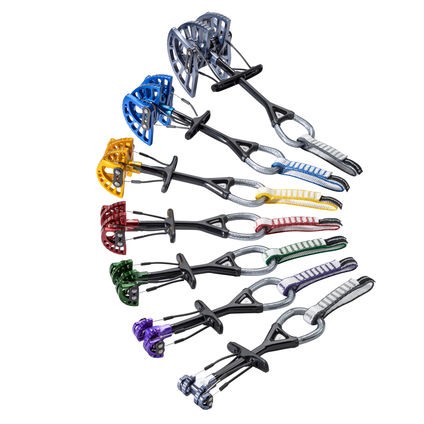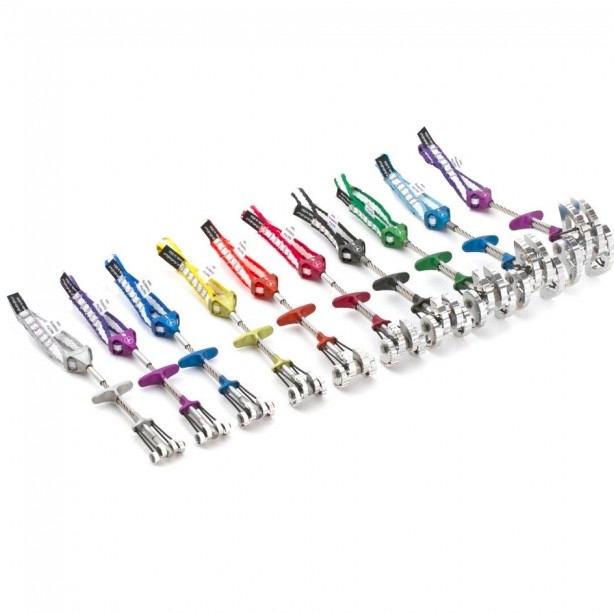For any climber who frequently finds themselves on long approaches, gear-intensive routes, or alpine adventures, the idea of “ultralight” in any aspect of gear is generally worth investigating. And with several new ultralight camming devices coming to market in the past year alone, there’s undoubted potential for some serious weight savings. But—as many have pondered—at what cost?
To make things easy for you, we’ve created this comparison guide, which outlines the differences, benefits, and specs of both the Black Diamond Ultralight Camalots and Metolius Ultralight Master Cams, so you can choose what ultralight cams (if any) are right for you.
Deal Alert: View this week’s best on-sale climbing gear
Black Diamond Camalot Ultralight
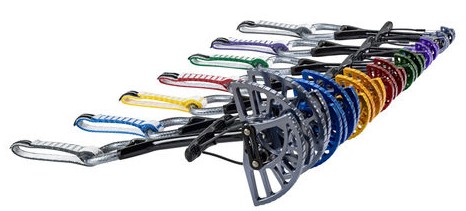
The Black Diamond Ultralight Camalots parallel the already loved and trusted Camalot C4s (now simply referred to as Camalots) in camming range, color-coding, and double-axle design—but these spring-loaded camming devices have been made 25% lighter. Black Diamond created these cams in sizes #0.4 – #4, leaving out the #0.3, #5, and #6, for several reasons, but primarily due to less weight savings being achievable with the larger sizes.
Differences from the standard Camalot
With weight savings ranging from 21-29% per cam (depending on size). Replacing a single rack of #.4-4 Camalots with ULs results in an overall reduction of 239 g (8.43 oz); even more weight savings are offered if you’re replacing doubles. Without a doubt, incorporating Ultralight Camalots can make a noticeable difference for your rack load.
Weight reduction features
- Integrated a 14mm Dyneema tape sling, which is slimmer and lower-profile
- Replaced the C4’s steel stem cable with a dyneema core stem
- Designed sculpted lobes with openings to reduce more weight
- Incorporated smaller diameter trigger wires
Spec comparison
As you can see from the spec comparison below, this weight reduction favors larger cams most (a #0.4 will save you around 22 grams, whereas a #4 will save just over 62 grams). And, importantly to note, with the Camalot Ultralights, less weight does come with a reduction in overall strength (albeit a considerably minimal one) at about 2 kN less per cam.
Camalot

Weight
- [0.3] 75 g (2.65 oz)
- [0.4] 83 g (2.93 oz)
- [0.5] 99 g (3.49 oz)
- [0.75] 119 g (4.18 oz)
- [1] 136 g (4.8 oz)
- [2] 155 g (5.47 oz)
- [3] 201 g (7.1 oz)
- [4] 289 g (10.2 oz)
- [5] 380 g (13.4 oz)
- [6] 557 g (1 lb 4 oz)
Strength
- [0.3] 8 kN (1798 lbf)
- [0.4] 10 kN (2248 lbf)
- [0.5] 12 kN (2698 lbf)
- [0.75-6] 14 kN (3147 lbf)
Range
- [0.3] 13.8-23.4 mm (0.54-0.92 in)
- [0.4] 15.5-26.7 mm (0.61-1.05 in)
- [0.5] 19.6-33.5 mm (0.77-1.32 in)
- [0.75] 23.9-41.2 mm (0.94-1.62 in)
- [1] 30.2-52.1 mm (1.19-2.05 in)
- [2] 37.2-64.9 mm (1.46-2.55 in)
- [3] 50.7-87.9 mm (2.00-3.46 in)
- [4] 66.0-114.7 mm (2.60-4.51 in)
- [5] 85.4-148.5 mm (3.36-5.85 in)
- [6] 114.1-195.0 mm (4.50-7.68 in)
Camalot Ultralight

UL Weight
- [.4] 61 g (2.15.oz)
- [.5] 74 g (2.61 oz)
- [.75] 89 g (3.14 oz)
- [1] 101 g (3.56 oz)
- [2] 126 g (4.44 oz)
- [3] 167 g (5.89 oz)
- [4] 225 g (7.94 oz)
UL Strength
- [.4] 8 kN (1798 lbf)
- [.5] 10 kN (2248 lbf)
- [.75] 12 kN (2698 lbf)
- [1] 12 kN (2698 lbf)
- [2] 12 kN (2698 lbf)
- [3] 12 kN (2698 lbf)
- [4] 12 kN (2698 lbf)
UL Range
- [.4] 15.5-26.7 mm (0.61-1.04 in)
- [.5] 19.6-33.5 mm (0.77-1.32 in)
- [.75] 23.9-41.2 mm (0.94-1.62 in)
- [1] 30.2-52.1 mm (1.19-2.05 in)
- [2] 37.2-64.9 mm (1.46-2.55 in)
- [3] 50.7-87.9 mm (2.00-3.46 in)
- [4] 66.0-114.7 mm (2.60-4.51in)
Cam range comparison
As mentioned, the Ultralight Camalots crossover with the Camalots (C4s) in cam range sizes, but if you’re going for a well-rounded rack, you’re likely going to have a variety of different cam sizes and styles. The chart below shows how various Camalots overlap in range:
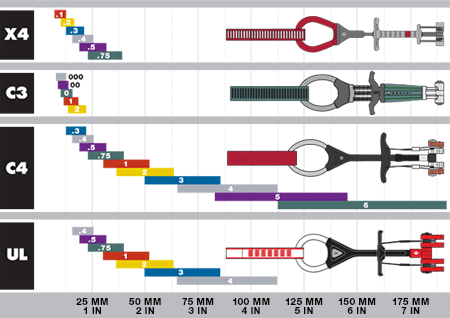
BD Camalot range comparison. Image: Black Diamond
Price comparison
While the benefits of going ultralight are undoubted, you’ll pay a steeper price (roughly $25 more per cam). Here are how prices between the regular Camalot and the Ultralights compare:
Camalot
- [.4 – .75] = $64.95
- [1] = $69.95
- [2 – 3] = $74.95
- [4] = $89.95
Camalot Ultralight
- [.4 – 1] = $89.95
- [2] = $99.95
- [3] = $109.95
- [4] = $129.95
Additional considerations
The Camalot Ultralights feature a more ergonomic design in the stem and thumb loop, intended to ease the process of placing and cleaning gear.
As with their other cams, Black Diamond will change out the preset slings for you—simply send them in for replacement, as necessary. The Dyneema stem of the cam cannot be replaced.
The BD Ultralights are UV protected, which supports the longevity and exposure that these cams can handle. Like with all gear though, longevity will be determined by the frequency and terrain in which you use your gear.
All Black Diamond Camalots are made in Salt Lake City, Utah.
Hear a brief overview of the Ultralights from Black Diamond’s Climbing Category Director:
Reviews / awards
A consumer review:
Not only will this save you on approaches, but placing the cams is effortless, and you will notice the difference on your harness. The #4 in particular is considerably easier to maneuver on your harness and in your hand. These aren’t my daily driver, but they will definitely be on my next Winds trip!
– Grant Burton, via Backcountry.com
The Camalot Ultralight has also received the following awards:



Metolius Ultralight Master Cam
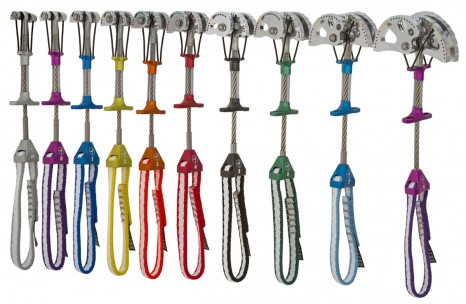
Considered one of the best small camming devices on the market due to their already light weight, narrow head, flexible single-stem design, and affordable price, the original Metolius Master Cams already stand as a highly trusted form of trad protection for small and more obscure cracks and features.
These cams, like the Black Diamond Camalots, are also color-coded by size, although Metolius uses a different pattern than BD relative to their sizes. They feature a replaceable Monster sling (a custom blend of nylon/Dyneema) and uniquely provide a Range Finder system, which helps you identify a solid placement (using green-to-red colored dots) to ensure you don’t over or under cam your device (see image below).
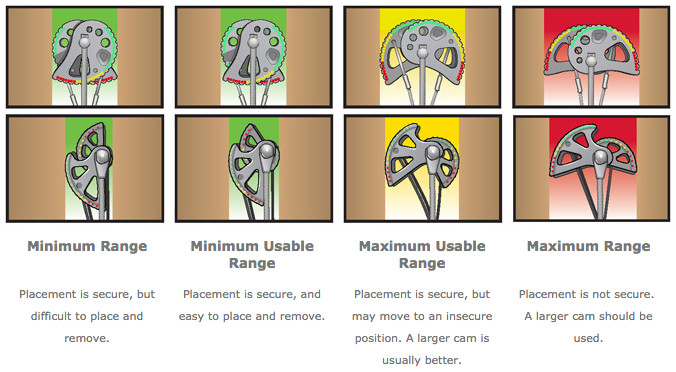
Range Finder chart. Image: Metolius
With the loyal following that these cams already have, it’s no surprise that the new Ultralight version—which feature some significant upgrades—already have a growing following.
Differences from the standard Master Cam
The newly released Ultralight Master Cams weigh on average 20% less than the original Master Cams (now discontinued), and 40% less than most conventional cams without losing any camming range. The new ultralight variety come in 10 sizes, including #00 – #8 (Metolius added the #7 and #8 to this lineup, which are the approximate equivalent of a #2 and #3 Camalot).
Want more climbing content? Get our awesome climbing newsletter, delivered weekly.
These updated cams (which pair well with matching color-coded FS Mini II carabiners) feature a new jagged, tooth design on the lobes, which are CNC machined to ensure greater precision and security, while keeping your cams from walking in cracks. Sizes #5 – #8 include a thicker cable to alleviate concerns about the larger cams being flimsy.
Unlike the Ultralight Camalots, the smallest cams of the new Metolius line actually saw the most weight reduction (just over 30%), while the larger ones saw less weight reduction, as no metal was removed from the cam lobes to retain their strength.
Related: Cam Range Comparison for Trad Gear
Weight reduction features
- Introduced a 2-finger trigger bar made from carved anodized aluminum (reduces weight and improves grip)
- Altered attached cam sling from a 13mm to a 11mm Monster sling
- Incorporated a minimal silver braised fitting to replace the heavier copper swage connecting the wire and thumb pad
- Replaced the thumb loop with a sewn Dyneema sling that runs through to the thumb pad
Spec comparison
As noted above, the range of these Ultralight Master Cams hasn’t changed from their predecessors. Accordingly, no strength was lost with the new updates. Weight differences can be seen below:
Metolius Master Cam
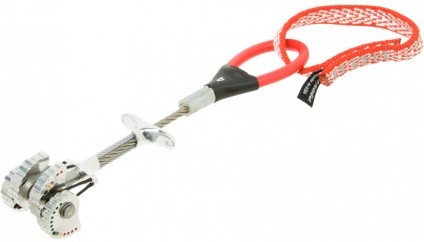
Weight
- [00] 62 g (2.2 oz)
- [0] 65 g (2.3 oz)
- [1] 68 g (2.4 oz)
- [2] 70 g (2.5 oz)
- [3] 82 g (2.9 oz)
- [4] 90 g (3.2 oz)
- [5] 98 g (3.5 oz)
- [6] 110 g (3.9 oz)
Strength
- [00-0] 5 kN (1100 lbf)
- [1] 8 kN (1800 lbf)
- [2 – 6] 10 kN (2250 lbf)
Ultralight Master Cam
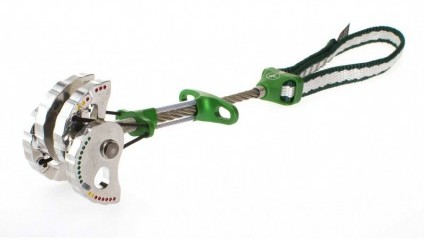
UL Weight
- [00] 45 g (1.6 oz)
- [0] 45 g (1.6 oz)
- [1] 52 g (1.8 oz)
- [2] 55 g (1.8 oz)
- [3] 65 g (2.3 oz)
- [4] 75 g (2.6 oz)
- [5] 85 g (3.0 oz)
- [6] 96 g (3.3 oz)
- [7] 112 g (3.9 oz)
- [8] 129 g (4.5 oz)
UL Strength
- [00-0] 5 kN (1100 lbf)
- [1] 8 kN (1800 lbf)
- [2 – 8] 10 kN (2250 lbf)
Cam range comparison
While the ranges haven’t changed from the original to the Ultralight Master Cams, the additional of the #7 and #8 size offers a significant expansion for some frequently desired sizes. See the Metolius cam range chart below:
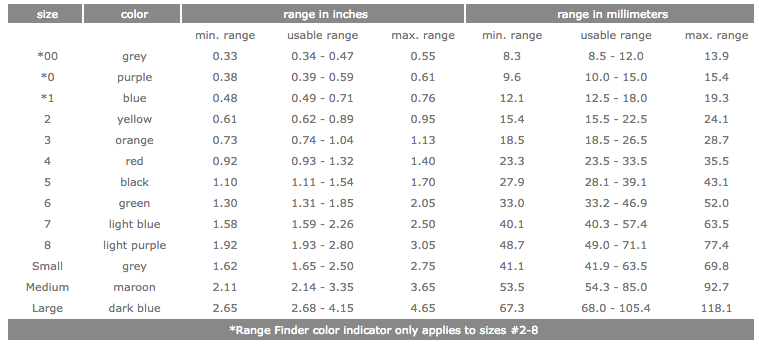
Price comparison
Lucky for all of us, the new Ultralight Master Cams, which are replacing the originals, feature no price increase. Below are the listed prices, by size. Definitely a solid value for the price.
- [00 – 6] = $59.95
- [7 – 8] = $64.95
Additional considerations
Metolius recommends replacing the slings every 5 years, which they will do for you for a small fee.
The Range Finder System is only found on sizes #2 – #8.
Metolius aims to release Offset UL Master Cams in Summer of 2016.
Metolius cams are made in Bend, Oregon.
Hear more about the Metolius Ultralight Master Cams from Beth Rodden:
Reviews / awards
Praise has been impressively high for the new release thus far. Here are a few review comments:
I’ll start by saying I’ve been using the original Metolius Master Cams for a few years and still have a set (and love them). But the new Metolius UL Master cams….dang. I think the guys at Metolius did a really nice job with the update.
– Jared Down via Backcountry.com
New to trad climbing but Ive always disliked the older mastercams triggers and wiring. With the newer, single wire, moveable sling, and light weight, I think theyve made a major upgrade for the better. A new teech pattern is also supposed to grip more but I dont have much experience to compare that feature
– John Martin via Backcountry.com
The Metolius Ultralight Master Cams received the following award:

Related: How to Build a Trad Rack
BD UL vs Metolius UL: side-by-side comparison

Building a trad rack is already quite a personal process. Every climber has their own set of unique preferences and biases, which can vary based upon preferred style, areas, and simply what kind of gear you’re used to using. That said, when it comes to choosing between Black Diamond’s Ultralight Camalots and Metolius’ Ultralight Master Cams, here are few things to consider:
Size variability
Black Diamond Camalots are made with a double-axel design, which offers a larger range per cam. Thus, with a rack of Ultralight Master Cams (single-stem design), you should consider that you’ll need an extra cam to cover the difference.
If you’re seeking ultralight cams for cracks smaller than about 1 inch, you’ll want to explore the Ultralight Master Cams, as the smallest size the Camalot Ultralights come in is the grey #0.4 (or approximate equivalent of a yellow #2 Master Cam).
For cams that work in cracks larger than 3 inches (i.e., blue #3 Camalot or new purple #8 Master Cam), you’d want to consider purchasing the larger Camalot Ultralights.
Weight differences
Notably, the Ultralight Master Cams see their greatest weight savings in the smallest sizes, whereas the largest weight savings for the Camalot Ultralights come in the largest sizes.
A set of Metolius Ultralight Master Cams (from Metolius sizes #2 – #8; the rough crossover in sizes between both) would weigh a total of 617 g (21.76 oz), while that rough equivalent set of Black Diamond Ultralight Camalots (#0.4 – #3 in BD sizes) would weigh a total of 618 g (21.79 oz).
Thus, these comparable sets of cams are nearly identical in weight; although, you’ll have an additional cam to carry and use with Ultralight Master Cams.
See a weight / range comparison for each size:
Camalot Ultralight
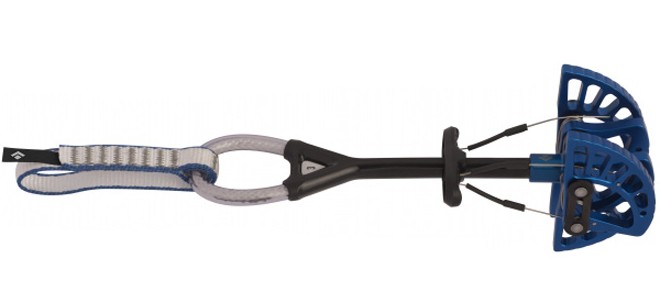
Weight / Range
- [.4] 61 g (2.15.oz) / 15.5-26.7 mm (0.61-1.04 in)
- [.5] 74 g (2.61 oz) / 19.6-33.5 mm (0.77-1.32 in)
- [.75] 89 g (3.14 oz) / 23.9-41.2 mm (0.94-1.62 in)
- [1] 101 g (3.56 oz) / 30.2-52.1 mm (1.19-2.05 in)
- [2] 126 g (4.44 oz) / 37.2-64.9 mm (1.46-2.55 in)
- [3] 167 g (5.89 oz) / 50.7-87.9 mm (2.00-3.46 in)
- [4] 225 g (7.94 oz) / 66.0-114.7 mm (2.60-4.51 in)
Ultralight Master Cam
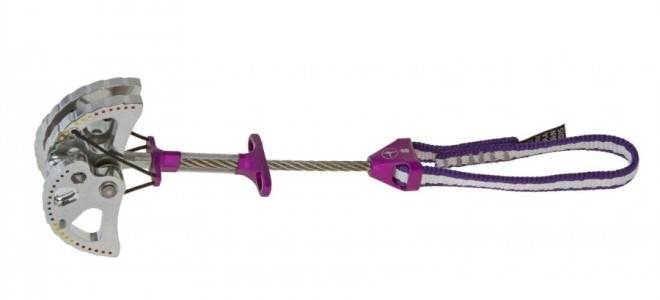
Weight/Range
- [00] 45 g (1.6 oz) / 8.5-12.0 mm (0.34-0.47 in)
- [0] 45 g (1.6 oz) / 10-15 mm (0.39-0.59 in)
- [1] 52 g (1.8 oz) / 12.5-18 mm (0.49 – 0.71 in)
- [2] 55 g (1.8 oz) / 15.5-22.5mm (0.62 – 0.89 in)
- [3] 65 g (2.3 oz) / 18.5-26.5 mm (0.74 – 1.04 in)
- [4] 75 g (2.6 oz) / 23.5-33.5 mm (0.93 – 1.32 in)
- [5] 85 g (3.0 oz) / 28-39.5 mm (1.01 – 1.56 in)
- [6] 96 g (3.3 oz) / 32.5-48 mm (1.28 – 1.89 in)
- [7] 112 g (3.9 oz) / 40-57.5 mm (1.57 – 2.26 in)
- [8] 129 g (4.5 oz) / 48.5-71.5 mm (1.91 – 2.81 in)
Price comparison
By only looking at the sizes that these ultralight camming devices roughly overlap in (about 1-3 inch cracks), you can see that there are considerable price differences. You can get a comparable rack of Metolius Ultralight Master Cams (from Metolius sizes #2 – #8) for just under $430, whereas roughly that same range of Black Diamond Ultralight Camalots (#0.4 – #3 in BD sizes) would cost you $570. That’s quite a stark difference to consider.
See the price comparison below:
Want more climbing content? Get our awesome climbing newsletter, delivered weekly.
Explore more
- How to Build a Trad Rack
- Cam Range Comparisons
- Free eBook: Ultimate Guide to Rock Climbing Knots, Bends, and Hitches
- Van Life: Essential Gear for Dirtbagging on the Road
- 23 Best Gifts for Rock Climbers
- Our 30+ most popular articles ever
- Gear Guide: Stoppers and Cams


